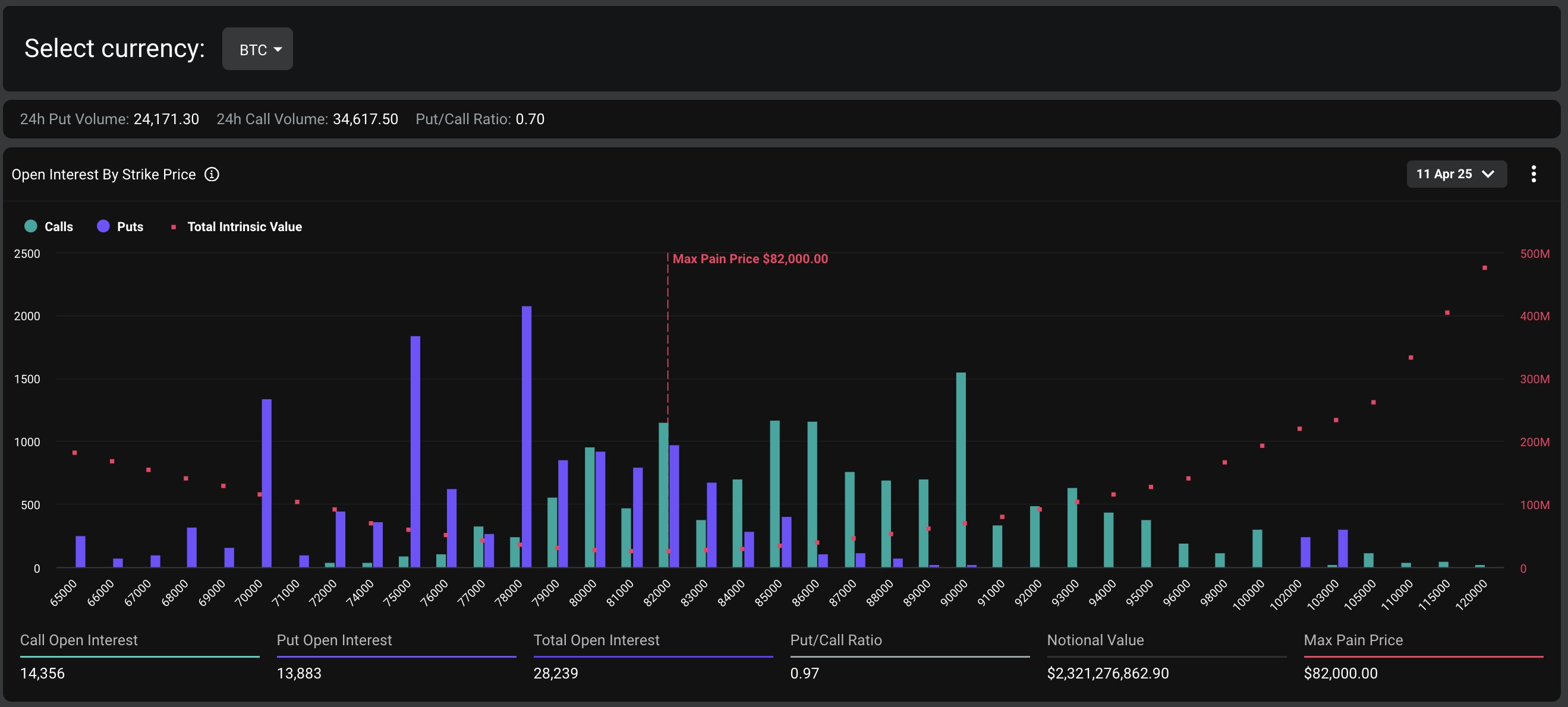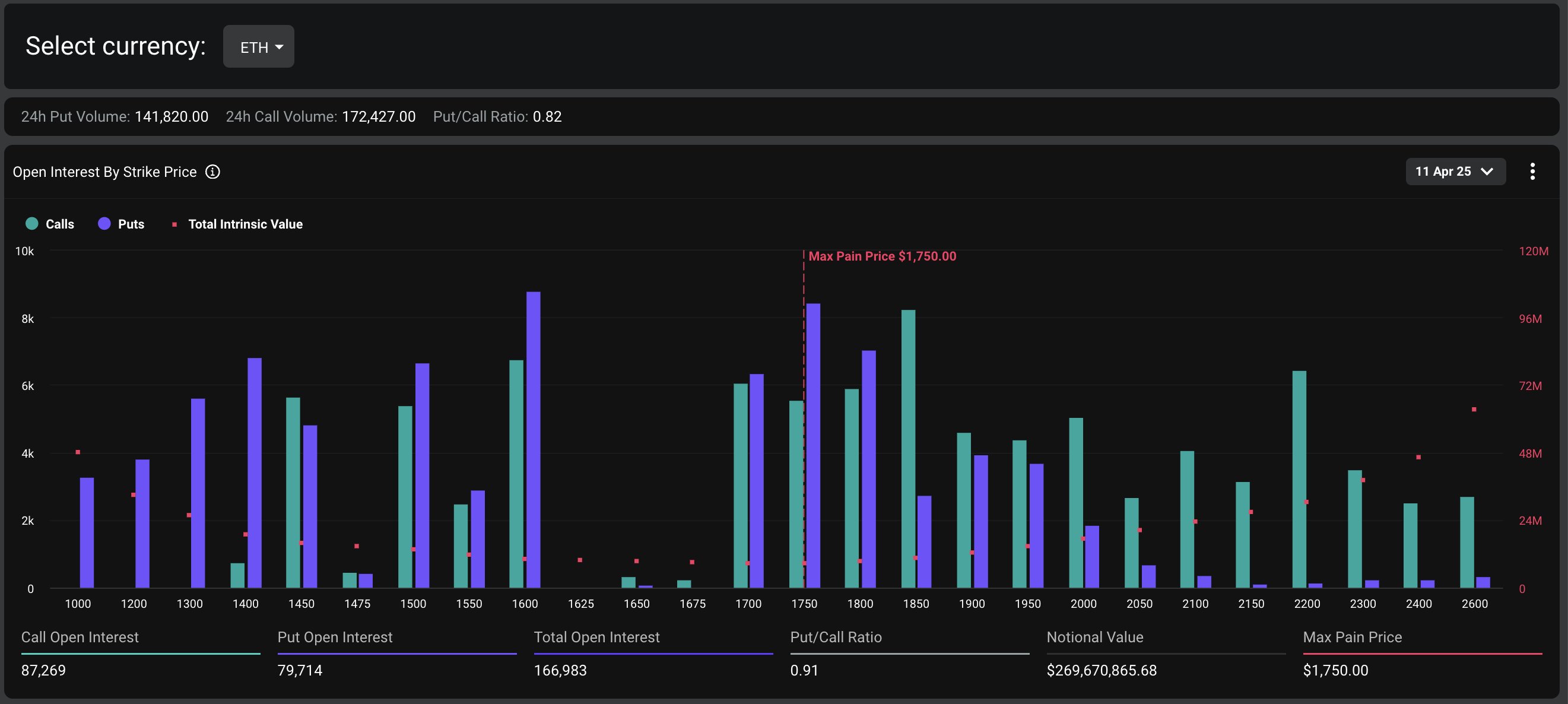Today, more than $2.5 billion worth of Ethereum (ETH) and Bitcoin (BTC) options will expire on cryptocurrency marketplaces.
Because it can affect short-term trends by affecting the volume of contracts about to expire and their notional value, traders pay close attention to this event. Looking at the put-to-call ratios and maximum pain points may help traders understand their expectations and potential market orientations.
Bitcoin and Ethereum options expiring today
The Bitcoin options that expire today have a notional value of $2.23 billion. Deribit’s data indicates that the put-to-call ratio for these 27,657 Bitcoin options that are about to expire is 0.86. This ratio implies a preponderance of buy options (calls) over sell options (puts).
The maximum pain point for these expiring options is $81,000, according to the statistics. The price at which the majority of contracts expire worthless is the biggest source of misery in cryptocurrency options trading. In this case, the asset will result in the most considerable financial losses for its investors.

Today is the expiration date of 183,468 Ethereum contracts in addition to Bitcoin options. The put-to-call ratio of these expiring options is 0.92, and their notional value is $283.6 million. The maximum pain point is $1,700.

Both Bitcoin and Ethereum are now trading below their maximum pain points. ETH is selling at $1,543, and BTC is at $80,622.
“With recent market volatility and ongoing tariff developments, how do you think these expiries will impact price action?” Deribit posed.
Deribit is an exchange for cryptocurrency futures and options. In fact, the instability of the trade war brought on by President Trump’s tariffs is causing the cryptocurrency markets to experience extreme volatility. Charles Hoskinson, the founder of Cardano, claims that future levies on cryptocurrencies will be useless.
He believes that future announcements will be a “dud” for the cryptocurrency market and that tariffs are already priced.
Traders brace for extended weakness as call premium fades until September
Deribit researchers also see a change in cryptocurrency options, with put demand continuing to be triggered by brief declines. The call premium, however, declines and is farther off of the curve.
Something’s shifting in crypto options 👀
Short-term dips still bring put demand, but the usual call premium further out the curve is fading.
You now have to look all the way to September before calls retake the skew.
Traders might be bracing for extended weakness.Watch this… pic.twitter.com/1bQl7DHbtx
— Deribit (@DeribitOfficial) April 10, 2025
This implies that traders may be anticipating prolonged decline in the cryptocurrency market. A fading call premium indicates that traders are less confident about short- to medium-term price rises when the implied volatility (IV) of calls declines in comparison to puts.
When investors fear price declines, equities markets frequently exhibit a negative or reverse volatility skew, with OTM puts (out-of-the-money puts) having a greater IV than OTM calls (out-of-the-money calls).
The cryptocurrency options market seems to follow this pattern, which reflects growing apprehension about potential negative outcomes. According to Greeks.live analysts, Bitcoin’s IV has dropped dramatically and currently holds close to 50% of all maturities.
However, ETH’s IV has remained higher, with short- to medium-term volatility being close to 80%. For traders, selling ETH options in the near future might be a wise move.
The US-China trade battle and other global economic uncertainties have reduced risk appetite. This cautious attitude may also be fueled by the inherent volatility of cryptocurrencies.
“Sentiment was more panicky this week, with Trump’s frequent switching of tariff policies making the market extremely risk averse,” analysts at Greeks.live wrote.
Deribit’s predictions of sustained decline are supported by the Greeks.live analysts. They do, however, anticipate a prolonged period of market volatility and uncertainty, in contrast to Hoskinson.
This implies that hedging techniques, like as purchasing puts or diversifying into stablecoins, are necessary for traders.
“Cryptocurrencies are currently suffering from a lack of new incoming money, a lack of new narratives, and a more subdued investor sentiment. In this worse market of bulls to bears, the probability of a black swan will be significantly higher, and buying some deep vanilla puts would be a good choice,” Greeks.live analysts concluded.
Trump signs law scrapping IRS DeFi broker rule, reversing key Biden-era policy
By signing the legislation, Trump overturned a Biden-era regulation that detractors said would hinder the rise of cryptocurrency and put a burden on small businesses.
A resolution to repeal an Internal Revenue Service (IRS) rule that would have mandated that some cryptocurrency brokers, including decentralized finance (DeFi) platforms, notify the tax agency of client transactions was signed by President Donald Trump on Thursday.
The action further demonstrates Trump’s support for the cryptocurrency sector and is a significant repeal of a tax reporting law from the Biden administration.
The IRS regulation, which was finalized in late 2024, was intended to make it clear that DeFi platforms were subject to the new broker reporting obligations.
The regulation was set to go into effect in 2026, although it was not yet in effect. Making ensuring cryptocurrency users paid taxes on asset sales was its main goal. According to Treasury estimates, billions of dollars’ worth of taxes tied to cryptocurrency are not being collected annually.
🚨 HISTORY MADE 🚨
Just now, @POTUS signed my bill to repeal to the IRS DeFi Crypto Broker Rule.
This is the first cryptocurrency bill EVER signed into law by a president.@HouseGOP is working to keep America as the crypto capital of the world!
— Congressman Mike Carey (@RepMikeCarey) April 10, 2025
Regulators face resistance after expanding broker scope to DeFi
The digital asset industry has criticized the rule. DeFi platforms don’t serve as middlemen like centralized exchanges like Coinbase or Kraken do. Additionally, they are unable to access user identities. Developers and executives argued that the regulation was dangerous from a legal and technological standpoint. They cautioned that it imposed impractical demands on permissionless procedures.
After the IRS broadened the definition of “broker” to encompass software-based DeFi solutions, industry lobbying grew more intense. Proponents of cryptocurrency criticized the government’s action as overreaching and warned that it would force development outside. Republicans supported their concerns and used the Congressional Review Act to stop the regulation.
Trump backs crypto industry in reversing DeFi tax mandate
With a simple majority, the resolution was approved by both houses of Congress in March. According to the Joint Committee on Taxation, the government could have to pay around $4 billion over a ten-year period to abolish the regulation.
Lawmakers who supported the repeal contended that privacy, technical viability, and innovation were more crucial than the anticipated loss. According to Rep. Mike Carey:
“The DeFi Broker Rule needlessly hindered American innovation, infringed on the privacy of everyday Americans, and was set to overwhelm the IRS with an overflow of new filings that it doesn’t have the infrastructure to handle during tax season.”
“With Trump’s signature, Congress reaffirmed its authority to write tax law rather than leaving it to regulators,” said Jason Smith, chairman of the Ways and Means Committee.
By promising to establish the US as a worldwide center for digital assets, Trump has established himself as a fervent advocate for the cryptocurrency sector.
Within weeks of his inauguration, his government declared a national Bitcoin reserve policy and swiftly established a federal working group on crypto regulation.
XRP price risks 40% drop to $1.20 if it doesn’t regain this level
The price of XRP is currently at a critical $2.0 support level; if this position is not maintained, the price might fall 40% to $1.20.
Notwithstanding a few encouraging events, the price of XRP has not gained traction and is circling the critical support level of $2.0, which, if broken, may result in a 40% decline to $1.20. Despite significant advancements in the SEC vs. Ripple litigation, the macro uncertainty and the Trump tariff war escalation have placed a pall over the cryptocurrency ecosystem, affecting XRP equally.
XRP price in a make it or break it position
The price of XRP has been circling around a critical support level of $2.0, and any direction change might determine the course of the market’s next movement. The Ripple cryptocurrency has recovered from the $1.9 levels once more in the past day, and it is now trading at $2.0. The daily trade volumes, however, have plummeted to $4.21 billion, a 51% decline.
Despite the strong recovery, cryptocurrency researcher Ali Martinez pointed out that XRP must break out of this breakout zone in order to sustain the climb. The price of XRP is creating a head and shoulders pattern, as seen in the picture below. Additionally, the gates are still open for a 40% decline to $1.20, but the immediate support is $1.80.

However, the cryptocurrency Ripple can chart its course for an upward breakout to $22, $30, and beyond if it can roar again over $2.0. According to cryptocurrency researcher EGRAG Crypto, a breakthrough over a multi-year timeline might result in a significant upward breakout. The expert pointed out:
“I’m looking at the last pump from the 2017 cycle, which was an incredible 2,600%! Starting from $1.20, if we see a retracement back to the edge of the triangle, then $30 is definitely within reach!”

On-chain and Ripple lawsuit developments
The Ripple blockchain has seen tremendous growth, according to XRP’s on-chain analytics. More than 6.26 million addresses now contain at least one XRP, setting a network record, according to on-chain expert Ali Martinez. Despite continuous market volatility, this milestone demonstrates robust investor confidence. Positive developments in the Ripple case are also causing discussions of a spot XRP ETF to pick up steam, which might spur an increase in the price of XRP.
Following their settlement of the XRP case, Ripple Labs and the US Securities and Exchange Commission (SEC) jointly filed a critical petition on Thursday. Both parties have asked that the appeal be placed on hold until the court formally accepts the resolutions, according to the document that was sent to the US Court of Appeals for the Second Circuit.


